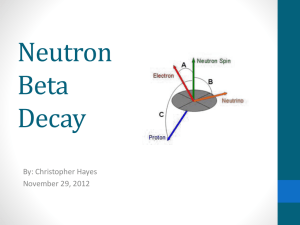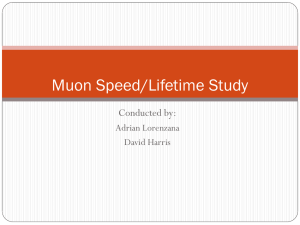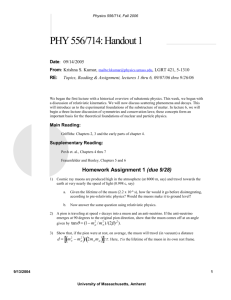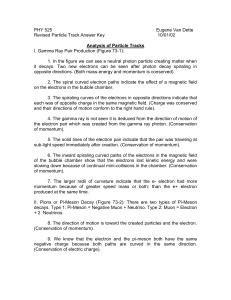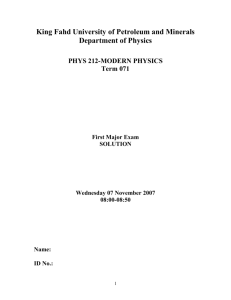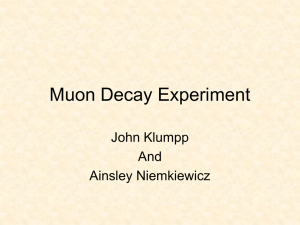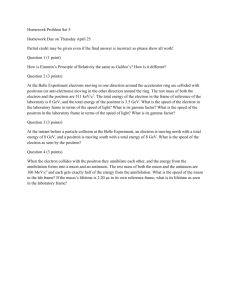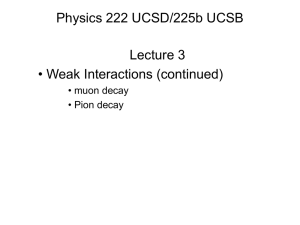Lecture 14
advertisement
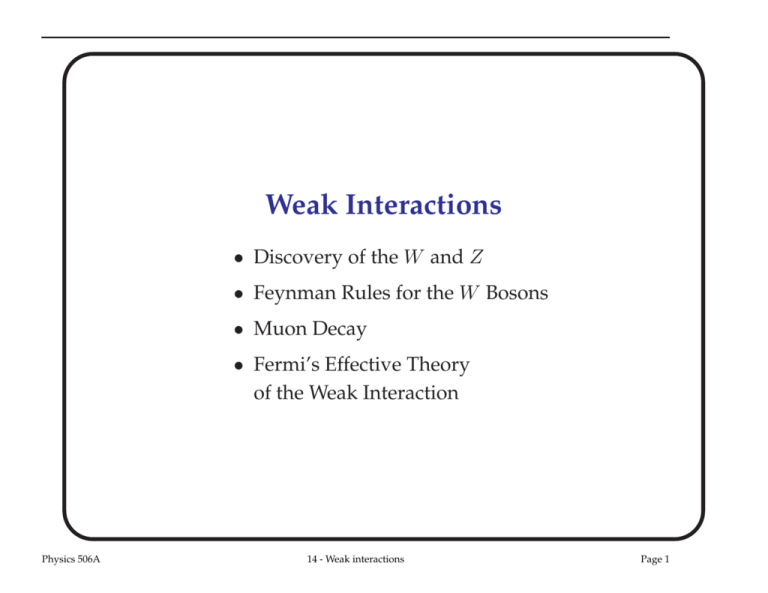
Weak Interactions
• Discovery of the W and Z
• Feynman Rules for the W Bosons
• Muon Decay
• Fermi’s Effective Theory
of the Weak Interaction
Physics 506A
14 - Weak interactions
Page 1
Intermediate Vector Bosons
• Like QED and QCD, the weak interaction is mediated by spin-1 (vector)
particle exchange.
• Unlike the photon and gluons, the weak mediators are massive:
MW = 80.425(38) GeV
MZ = 91.1876(21) GeV
This means that the longitudinal polarization mode is available, for a total of 3
independent polarizations.
• Evidence for the W (charged current weak interaction) is indirectly obtained
from the observation β-decay
• The Z 0 was indirectly observed in 1973 in the Gargamelle experiment at CERN
via the processes
Physics 506A
ν̄µ + e
→
ν̄µ + e
ν̄µ + N
→
ν̄µ + X
14 - Weak interactions
Page 2
UA1 Experiment
The W and Z 0 were directly observed in
1983 by the UA1 and UA2 detectors at
CERN via proton-antiproton collisions.
UA1 and UA2 experiments (UA = underground area) were the first large 4π
detectors with a large volume tracking
chamber and a magnetic field.
A 4π detector allows one to measure the
neutrino or missing energy in an event,
needed for the observation of the
W → e ν decays.
Physics 506A
14 - Weak interactions
Page 3
First proton-antiproton collider
The accelerator used active feedback to reduce the transverse motion of the
antiproton beam. The development by van der Meer won him the Nobel Prize.
Physics 506A
14 - Weak interactions
Page 4
Vertex and Propagator for the Bosons
• The W bosons mediate charged current (CC) weak interactions. They couple to
leptons via
νℓ
−ig
√w
2 2
γ µ (1 − γ 5 )
W
ℓ−
• This interaction mixes vector (γ µ ) and axial vector (γ µ γ 5 ) terms.
We call this a V − A interaction and it leads to parity violation.
• The propogator is
“
−i gµν −
q2 −
Physics 506A
14 - Weak interactions
qµ qν
M2
M2
”
Page 5
Example:
νµ + e− → µ− + νe
Start with νµ + e− → µ− + νe which is experimentally possible
and then evaluate the muon decay rate µ− → e− + νµ + ν e
4:µ
3 : νe
W
1:e
M
=
»
i ū3
„
2 : νµ
0
„
« – −i gµν −
B
−igw µ
√ γ (1 − γ 5 ) u1 B
@
2
q 2 − MW
2 2
» „
« –
−igw ν
√ γ (1 − γ 5 ) u2
× ū4
2 2
Physics 506A
qµ qν
2
MW
14 - Weak interactions
«1
C
C
A
Page 6
II:
νµ + e− → µ− + νe
2 , the matrix element simplifies to
• For low momentum transfer q 2 ≪ MW
M
=
2
ˆ
˜ˆ
˜
gw
µ
5
5
ū
γ
(1
−
γ
)u
ū
γ
(1
−
γ
)u
3
1
4 µ
2
2
8MW
• Averaging over initial state spins and summing over final stste spins, we get
!2
D
E
2
˜
ˆ µ
1
gw
5
ν
5
⇒ |M|2
=
Tr
γ
(1
−
γ
)(/
p
+
m
)γ
(1
−
γ
)/
p
e
1
3
2
2 8MW
ˆ
˜
× Tr γµ (1 − γ 5 )/
p2 γν (1 − γ 5 )(/
p4 + mµ )
• Note the leading factor of
Physics 506A
1
2
(electrons have 2 spins and the ν has 1 spin).
14 - Weak interactions
Page 7
III:
νµ + e− → µ− + νe
ˆ
˜
5
5
• We need to evaluate the traces Tr γµ (1 − γ )/
p2 γν (1 − γ )(/
p4 + mµ )
• Bring the (1 − γ 5 ) factors together first:
(1 − γ 5 )/
p2 γν (1 − γ 5 )
=
=
=
(1 − γ 5 )/
p2 (1 + γ 5 )γν
(1 − γ 5 )(1 − γ 5 )/
p2 γν
2(1 − γ 5 )/
p2 γν
• The m-dependent terms do not contribute to these traces, so we have
E
D
2
|M|
where
Physics 506A
=
i
h
4
gw
µ ν
µν
µνλσ
ν µ
p1λ p3σ
p1 p3 + p1 p3 − (p1 · p3 )g − iǫ
4
2MW
τ
× [p2µ p4ν + p2ν p4µ − (p2 · p4 )gµν − iǫµνκτ pκ
2 p4 ]
4
2gw
=
(p1 · p2 )(p3 · p4 )
4
MW
´
` λ σ
σ
ǫµνλσ ǫµνκτ = −2 δκ
δτ − δτλ δκ
14 - Weak interactions
Page 8
IV:
νµ + e− → µ− + νe
• We need to evaluate the two dot products.
In the CM frame and neglecting the mass of the electron,
˜
ˆ
(p1 · p2 ) =
(p1 + p2 )2 − p21 − p22 /2
ˆ
˜
=
(2E)2 − 0 − 0 /2
=
(p3 · p4 )
=
=
=
=
2E 2
˜
ˆ
(p3 + p4 )2 − p23 − p24 /2
˜
ˆ
(p1 + p2 )2 − 0 − m2µ /2
˜
ˆ 2
4E − m2µ /2
»
“ m ”2 –
µ
2E 2 1 −
2E
• This gives
D
Physics 506A
|M|2
E
=
“ m ”2 –
4 E4 »
8gw
µ
1
−
4
MW
2E
14 - Weak interactions
Page 9
V:
νµ + e− → µ− + νe
• We can convert this to a cross section:
dσ
dΩ
• One can show that
=
„
E
D
«2 S |M|2
|pf |
1
8π
(E1 + E2 )2 |pi |
»
“ m ”2 –
|pf |
µ
= 1−
|pi |
2E
• The angular distribution is
dσ
dΩ
=
1
2
2E
gw
2
4πMW
!2 »
1−
“ m ”2 – 2
µ
2E
Note that the cross section has no angular dependence.
Physics 506A
14 - Weak interactions
Page 10
Muon Decay µ− → e− + νµ + ν e
Muon decay has been studied for decades and continues to be studied today as a
means for testing the Standard Model and search for evidence of New Physics
3 : νµ
2 : ν̄e
4:e
W
1:µ
2 , the amplitude is
• Again, working in the limit of q 2 ≪ MW
M
=
2
˜
˜ˆ
ˆ
gw
5
µ
5
ū3 γ (1 − γ )u1 ū4 γµ (1 − γ )v2
2
8MW
• This is identical to the amplitude in the previous example, except for u2 → v2 ,
p2 in the trace (since mν = 0)
but both either spinors give us /
Physics 506A
14 - Weak interactions
Page 11
Muon Decay II
• We have the identical spin-averaged squared matrix element as e ν scattering
D
E
4
2gw
2
(p1 · p2 )(p3 · p4 )
|M|
=
4
MW
• Since the kinematics of µ decay are different from those of e νµ scattering, we
will need to start our work here.
• In the muon rest frame, (p1 · p2 ) = mµ E2 , and
˜
ˆ
(p3 · p4 ) =
(p3 + p4 )2 − p23 − p24 /2
ˆ
˜
2
=
(p1 − p2 ) − 0 − 0 /2
˜
ˆ 2
2
=
p1 + p2 − 2p1 · p2 /2
=
mµ (mµ − 2E2 )/2
• The spin-averaged squared matrix element simplifies to
D
E
4
gw
2
2
|M|
=
m
µ E2 (mµ − 2E2 )
4
MW
Physics 506A
14 - Weak interactions
Page 12
Muon Decay III
D
• Since |M|
2
E
(via E2 ) depends nontrivially on θ, we will have to work out
the decay rate from scratch with Fermi’s Golden Rule:
E
D
2 „
«„
«„
«
|M|
d3 p2
d3 p3
d3 p4
dΓµ =
2mµ
(2π)3 2E2
(2π)3 2E3
(2π)3 2E4
× (2π)4 δ 4 (p1 − p2 − p3 − p4 )
• Rather than list the derivation in the lectures, the reader is encouraged to
review it in Griffiths
Physics 506A
14 - Weak interactions
Page 13
Muon Decay IV
• The derivation of the matrix element yields valuable kinematic information
max{E2 , E4 }
⇒
8
>
>
<
>
>
:
<
1
m
2 µ
E2 <
E4 <
(E2 + E4 ) >
<
1
m
2 µ
1
m
2 µ
1
m
2 µ
(E2 + E4 )
9
>
>
=
>
>
;
• Since all three final-state particles are assumed to be massless, energy and
3-momentum are the same.
• The sum of the momenta for the 3 final-state particles must be zero, therefore
no single particle can have more than half of the available energy and no two
particles can have less than half of the available energy.
Physics 506A
14 - Weak interactions
Page 14
Electron energy spectrum in muon decay
• One can measure the lifetime of decay width of muon decay
Often one measures the momentum spectrum of the outgoing electron
• The following equation describes the electron-energy spectrum of muon decay.
dΓµ
dE
Physics 506A
=
„
gw
MW
«4
14 - Weak interactions
m2µ E 2
2(4π)3
„
4E
1−
3mµ
«
Page 15
Electron energy spectrum data
Physics 506A
14 - Weak interactions
Page 16
Muon Decay Rate
• Integrating over the electron energy, we obtain the muon decay rate:
«
«
„
„
Z mµ /2
4E
gw 4 m2µ
2
dE
E
1−
Γµ =
MW
2(4π)3 0
3mµ
„
«
gw 4 5
1
mµ
=
6144π 3 MW
2 , our results always depend on the ratio of g and
• In the limit of q 2 ≪ MW
w
MW , and not the two constants separately.
Hence we can define the Fermi coupling constant GF , by GF =
√ 2
2gw
2
8MW
• This allows us to write the muon lifetime as
192π 3
τµ = 2 5
GF mµ
Physics 506A
14 - Weak interactions
Page 17
Fermi Coupling constant
• We can use the measurement of the muon mass and lifetime to measure the
Fermi coupling constant
192π 3
τµ = 2 5
GF mµ
• Muon mass and lifetime (2007 PDG)
Mµ = 105.658369 ± 0.000009 MeV
τµ = (2.19703 ± 0.0004) × 10−6 seconds
• Using τµ and mµ , we can determine GF from this equation:
GF = 1.16637(1) × 10−5 GeV−2
Physics 506A
14 - Weak interactions
Page 18
How Weak is the Weak Interaction?
• The muon lifetime and mass measurements give
√ 2
2gw
−5
−2
GF =
=
1.166
×
10
GeV
2
8MW
• We can use the W mass measurement MW = 80.4 GeV to determine gw .
gw = 0.65
⇒ αw
2
1
gw
=
=
4π
29
• The weak interaction is inherently stronger than the EM interaction!
2 which makes the weak force seem so
It is only the suppression factor E 2 /MW
feeble.
Physics 506A
14 - Weak interactions
Page 19
Twist experiment at TRIUMF I
• The electron energy spectrum is measured by the (active) TWIST experiment
at TRIUMF.
• Since this experiment uses polarized muons, the direction of the electron is no
longer arbitrary, and a distribution in E and θ is created.
• if the systematic uncertainties are made sufficiently small, one can look for
evidence of physics beyond the Standard Model
(e.g., right-handed charged-current interactions via WR bosons).
Physics 506A
14 - Weak interactions
Page 20
Muon production at TRIUMF
Muons are directed into the detector where the electron momentum is measured.
Physics 506A
14 - Weak interactions
Page 21
Physics 506A
14 - Weak interactions
Page 22
Michel parameters
• Experiments such as Twist measure the angular and momentum dependence
of the outgoing electron
• Rather than assume the nominal form of the weak interaction V − A, we can
test for scalar, pseudoscalar and other tensor components
• Michel spectrum (see µ section in PDG)
ff
1
−
x
2ρ
dΓ
≈ x2 3(1 − x) +
(4x − 3) + 3η x0
dxdcosθ
3
x
–
»
2δ
(4x − 3)
± x2 Pµ ξ cosθ 1 − x +
3
where x = Eµ /W , x0 = me /W and W = (m2µ + m2e )/2mµ
• In the Standard Model, ρ = ξδ = 0.75, ξ = 1, and η = 0
Physics 506A
14 - Weak interactions
Page 23
